What is CNC Swiss Precision Machining?
CNC Swiss precision machining, also called Swiss-type or sliding-head machining, uses a sliding headstock lathe to process bar stock. The material is supported by a guide bushing, exposing only the portion being machined. Multi-axis turrets and live tooling allow turning, milling, drilling, threading, and grooving in a single setup, reducing errors and improving efficiency.
This process is ideal for small-diameter, high length-to-diameter ratio parts requiring extremely tight tolerances.

Why Choose Swiss-Type CNC Machining?
- Ultra-High Precision: Guide bushing support minimizes vibration, achieving tolerances down to ±0.0002 in (±0.005 mm).
- Single-Setup Multi-Operation: Multi-axis live tooling enables turning, drilling, milling, threading, and chamfering without removing the part.
- High Efficiency: Continuous feed and multiple simultaneous tools reduce cycle time.
- Superior Surface Finish: Reduced vibration leads to excellent surface quality, often eliminating additional finishing.
- Material Savings: Minimizes scrap, especially for expensive alloys.
- Ideal for Long, Thin Parts: Maintains stability for high length-to-diameter ratio components.
- Handles Difficult Materials: Stainless steel, titanium, nickel alloys, and other engineering materials.

Xavier’s Capabilities
- Typical Diameters: 0.5 mm to 32 mm bar stock.
- High Length-to-Diameter Ratio Support with guide bushing stabilization.
- Multi-Axis Turrets: Up to 13 axes with live tooling for complex geometries.
- Coolant System: Oil-based cooling for temperature control and tool longevity.
- Inspection: CMM measurement, material certificates, and traceable quality documentation.
Industries Served
- Medical Devices: Implants, micro-connectors, screws, and dental components.
- Aerospace: Small connectors, valve cores, sensors.
- Electronics & Communication: Micro-connectors, pins, fine leads.
- Automotive: Sensors, small shafts, injectors.
- Precision Instruments: Measurement needles, instrument shafts, and micro components.
Cost & Lead Time
- Price depends on drawings, materials, surface finish, batch size, and required inspection reports.
- Small prototypes have higher per-piece costs, whereas medium-to-large production benefits from Swiss efficiency.
- Optimized design and standard tolerances help reduce cost.
- Rapid prototyping and continuous production are available.

Quality Assurance
- ISO-certified processes and quality management.
- CMM inspection ensures dimensional accuracy.
- Material traceability with certificates.
- Strict process controls for consistent production.
- Technical support and DFM advice for long-term partnerships.
FAQs
- Difference from conventional CNC turning: Guide bushing + sliding headstock minimizes vibration, ideal for long, thin, precise parts.
- Minimum diameter / tolerances: Can handle micro-diameter parts with micron-level tolerances.
- Materials: Stainless steel, aluminum, copper, titanium, nickel alloys.
- What info is needed for a quote: 2D/3D drawings, material, target tolerances, quantity, surface finish, inspection requirements.
- Lead time: Depends on batch size; rapid prototype and volume production available.
Why Choose Xavier
Xavier specializes in Swiss-type CNC machining for micro-complex components, providing high precision, single-setup machining, material traceability, and ISO-certified quality control. From prototype to volume production, Xavier delivers reliable, efficient, and repeatable Swiss precision machining solutions.
Some content in this article is sourced from the internet. If there is any inappropriate content, please contact us for handling.